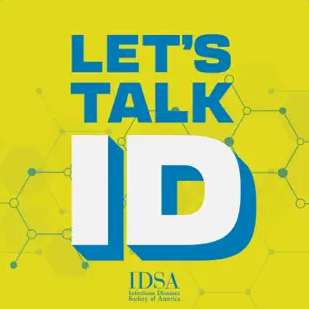What we’re hearing: Top associations in clinical ID, ID/EIS fellowship and growing the ID workforce
Facebook Twitter LinkedIn Email Recent episodes of the “Let’s Talk ID” podcast have covered a range of topics, from a draft of favorite associations in clinical ID (think rose thorns and sporotrichosis) to a new joint fellowship for ID physicians interested in CDC’s Epidemic Intelligence Service and a loan repayment program to help bolster the ID workforce.
Recent episodes of the “Let’s Talk ID” podcast have covered a range of topics, from a draft of favorite associations in clinical ID (think rose thorns and sporotrichosis) to a new joint fellowship for ID physicians interested in CDC’s Epidemic Intelligence Service and a loan repayment program to help bolster the ID workforce.
On the latter topic, IDSA President Carlos del Rio, MD, FIDSA, spoke with Paul Pottinger, MD, DTMH, FIDSA, at the University of Washington and Emily Spivak, MD, MHS, FIDSA, from the University of Utah about the Bio-Preparedness Workforce Pilot Program. They covered how it can help address ID workforce needs and how they got involved in advocacy to help advance the effort on Capitol Hill. In the episode, Dr. Pottinger explained why he got involved:
One of the things I do here at the University of Washington is to serve as director of our ID fellowship program. I hear this from our applicants and from our fellows and our graduates: Debt relief is an attractive option. It’s something that can help draw people into the field if they are on the fence, or they’re sincerely, and I think reasonably understandably, worried about the amount of debt that they have acquired during their medical education.
While IDSA works on other ways to improve compensation for people who do the work of ID, this is something that can get things started in the right direction. I got involved because this is what our fellows have asked for, but I also got involved because it was fun to do something different. I would say, I think ID is all about advocacy in general, right? We advocate for our patients. We advocate for our colleagues. This is a way for me to advocate in some small way on behalf of all of us who do the work of ID and to feel like I was having an impact beyond the walls of my clinic room or the hospital room where I’m seeing a particular patient.
Speaking of the ID workforce, Dr. del Rio discussed the ID/EIS fellowship, a four-year pilot program, launched by IDSA with funding from CDC, that streamlines a career path for applicants interested in both ID fellowship and the EIS program. His guests on the episode were Molly Paras, MD, FIDSA, program director for the Massachusetts General Hospital/Brigham and Women’s Hospital Infectious Diseases Fellowship Program, and Eric Pevzner, PhD, MPH, of CDC.
Dr. Paras explained the types of jobs the new program would prepare joint fellows for:
I would think you could take the skill set learned during your combination of ID fellowship and EIS training to a wide variety of careers, including work with public health departments either at the national or local level and everywhere in between. I would also see that this could kick-start an academic career for people who want to pursue physician-scientist work and research in the public health sector.
I think it would really give people those strong tools to be able to do that. And quite frankly, everything in between, from more clinical work all the way to the physician-scientist path. I think the networking opportunities and training opportunities that come from both ID fellowship and the EIS training will really set people up for success in whatever their career path ends up looking like.
One of the things Rebeca Plank, MD, MPH, of Merck and Brigham and Women’s Hospital, loves about ID as a career is that it’s often related to a narrative: Where did you go? What did you do while you were there? Did you have any contact with animals, and do you have any pets? So it made sense that her number one pick for a favorite ID association was poker players’ pneumonia. As she told episode host Paul Sax, MD, FIDSA, during a game mirroring a fantasy sports draft:
The thing about ID and associations is that sometimes infections become associated with place names, and sometimes they become associated with people’s names, people who have discovered them or identified the agent. But when they’re associated with activities, I think it’s the most fun for me. And poker players’ pneumonia, as most people will remember, I’m sure, it turned out to be a Coxiella infection that was associated with not really playing poker but with a parturient cat.
As it turns out, parturient animals have long been associated with Coxiella infection, and that’s all over the world. You can call it poker players’ pneumonia, you can call it an abattoir workers’ pneumonia, you can call it sheep farmers’ pneumonia, and of course, it also has a myriad clinical presentations. Coxiella, because it is associated with so many locations, so many activities and so many routes of infection, it’s kind of the perfect Venn diagram with culture negative endocarditis because that also can be anything. And depending on your exposure history, you can go down a lot of rabbit holes, so to speak. But yes, poker players’ pneumonia is my number one ID association.
Don’t miss the entire draft, which includes appearances from rabbits, lawnmowers, cats, triathletes and soft cheeses, among others. The full episode and all the “Let’s Talk ID” podcasts are available on Apple Podcasts, Google Podcasts and Spotify.
Editor’s Note: The podcast excerpts above have been lightly edited for clarity.


